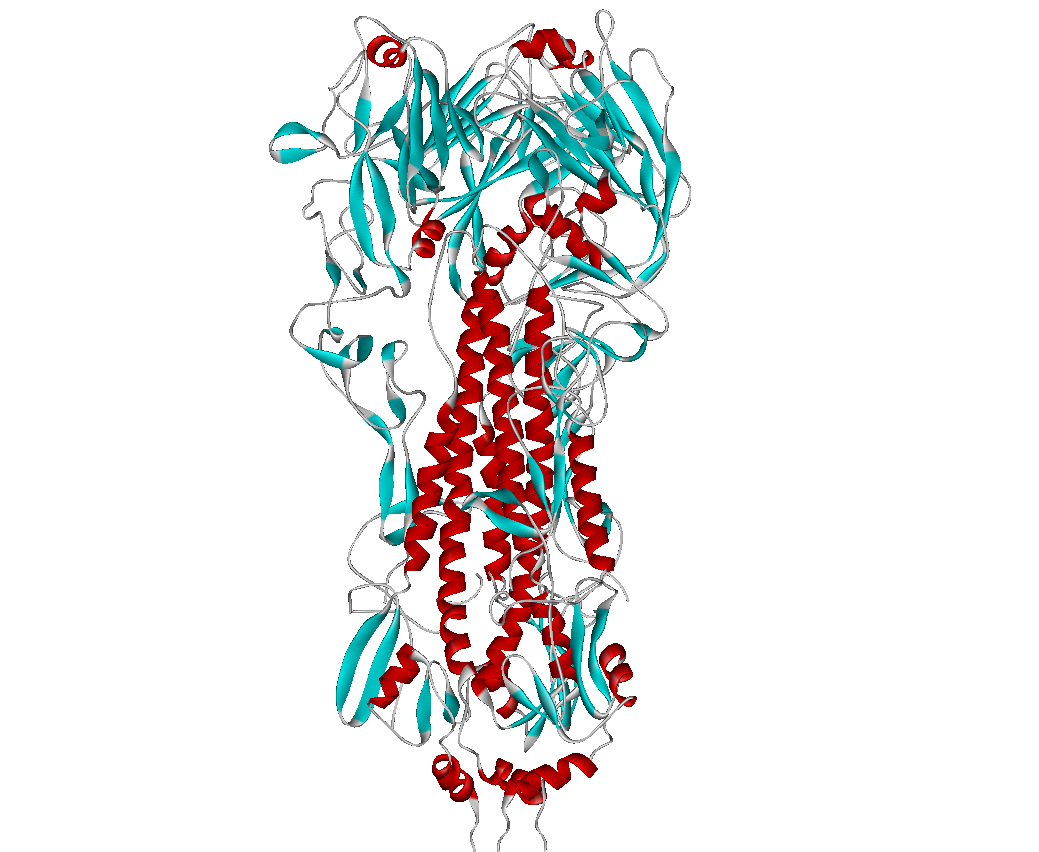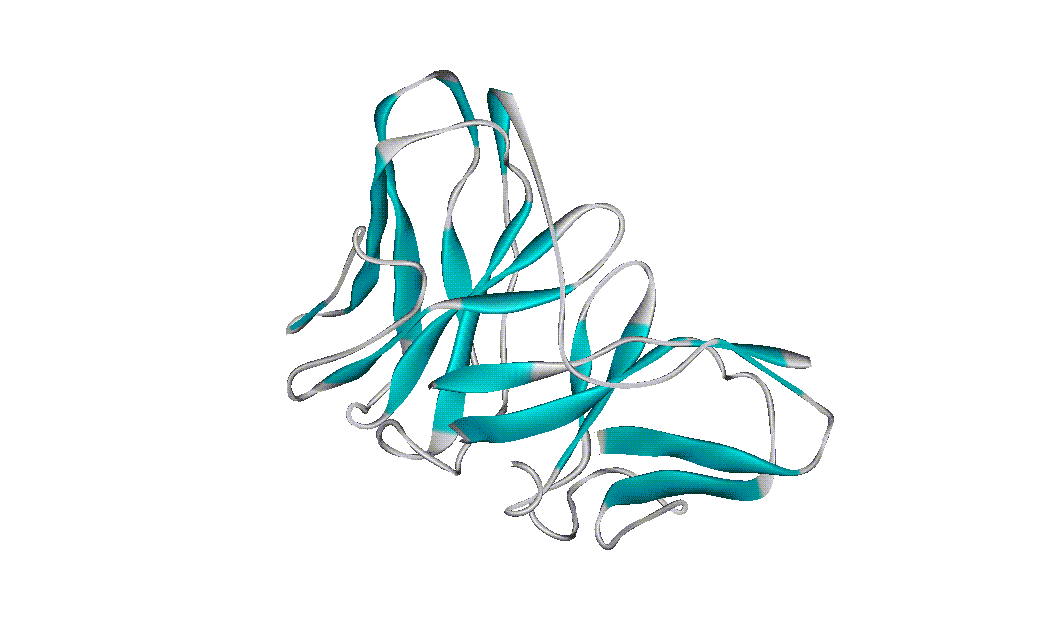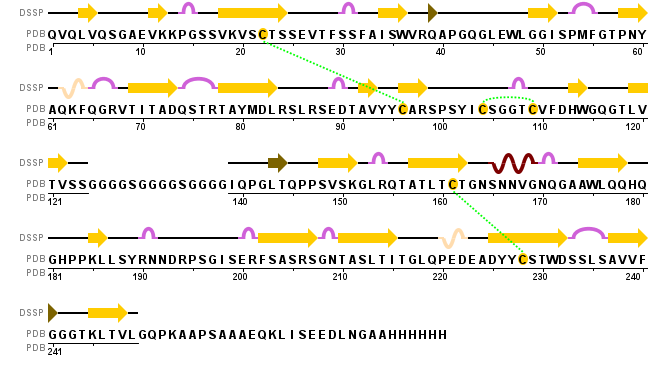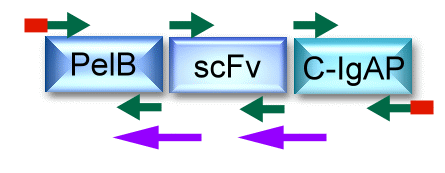Team:NYMU-Taipei/Project/Receptor/Antibody
From 2009.igem.org
Daadracula (Talk | contribs) (→Motivation:) |
Daadracula (Talk | contribs) |
||
| Line 45: | Line 45: | ||
Select an appropriate antibody to bind to Hemagglutinin. | Select an appropriate antibody to bind to Hemagglutinin. | ||
==Hemagglutinin (Target):== | ==Hemagglutinin (Target):== | ||
| - | [[ | + | [[image:NYMU HA5stx.PNG|right|450px]] |
===Functions:=== | ===Functions:=== | ||
*Allowing the recognition of target vertebrate cells, accomplished through the binding of these cells' sialic acid-containing receptors, and | *Allowing the recognition of target vertebrate cells, accomplished through the binding of these cells' sialic acid-containing receptors, and | ||
| Line 64: | Line 64: | ||
*Our antibody can bind to the highly conserved region in HA on many subtype Influenza A virus. Because our antibody bind to a common epitope that is a highly conserved pocket in the stem region of Hemagglutinin containing the '''fusion peptide'''. | *Our antibody can bind to the highly conserved region in HA on many subtype Influenza A virus. Because our antibody bind to a common epitope that is a highly conserved pocket in the stem region of Hemagglutinin containing the '''fusion peptide'''. | ||
**fusion peptide:Fusion of the influenza virus envelope with the endosomal membrane of host cells is mediated by fusion peptide (a domain of HA) | **fusion peptide:Fusion of the influenza virus envelope with the endosomal membrane of host cells is mediated by fusion peptide (a domain of HA) | ||
| - | [[ | + | [[image:NYMU F10Scfv.gif|right|500px|]] |
*Finally we choose '''F10'''(name of antibody) | *Finally we choose '''F10'''(name of antibody) | ||
| - | [[ | + | [[image:NYMU_ScFv_chain.PNG|none|550px]] |
ref:[http://www.nature.com/nsmb/journal/v16/n3/full/nsmb.1566.html Structural and functional bases for broad-spectrum neutralization of avian and human influenza A viruses] | ref:[http://www.nature.com/nsmb/journal/v16/n3/full/nsmb.1566.html Structural and functional bases for broad-spectrum neutralization of avian and human influenza A viruses] | ||
| Line 105: | Line 105: | ||
|T|B0012||}} | |T|B0012||}} | ||
| - | [[ | + | [[image:NYMU Fusion scfv2.gif|none|thumb|300px]] |
1.ompA suit: | 1.ompA suit: | ||
F:gaattcgcggccgcttctagag CATATGAAAGCTACTAAACTGGTACTG Tm:55C GC:37% | F:gaattcgcggccgcttctagag CATATGAAAGCTACTAAACTGGTACTG Tm:55C GC:37% | ||
| Line 126: | Line 126: | ||
|T|B0012||}} | |T|B0012||}} | ||
| - | [[ | + | [[image:NYMU Fusion scfv.gif|none|thumb|350px|]] |
1.PelB: | 1.PelB: | ||
F:gaattcgcggccgcttctag ATGAAATACCTGCTGCCGA Tm:55C GC:47% | F:gaattcgcggccgcttctag ATGAAATACCTGCTGCCGA Tm:55C GC:47% | ||
| Line 142: | Line 142: | ||
=Modeling= | =Modeling= | ||
| - | [[ | + | [[image:NYMU scFvH5.gif|450px|]] |
=Experiment and result= | =Experiment and result= | ||
Revision as of 22:01, 21 October 2009
| Home | Project Overview: | Chassis | Receptors | Removal | Experiments and Parts | F.A.Q | About Us |
Contents |
Motivation:
Seasonal flu has scourge a lot of people from the world.
- 1918 H1N1(Spanish flu):Killing over 40,000,000 people
- 1957 H2N2(Asian Flu): Killing over 4,000,000 people
- 1968 H3N2(Hong Kong Flu):Killing over 1,000,000 people
- Current H5N1
- This year H1N1: The number of people dying is still increasing.
- An average of 25,000~50,000 people died of influenza in a single year.
Influenza causes serious health threats because Influenza (RNA virus) has the ability to evade the immune system through rapid genetic mutation.
Occasionally, viruses are transmitted to other species and may then cause devastating outbreaks in domestic poultry or give rise to human influenza pandemics.
The type A viruses are the most virulent human pathogens among the three influenza types and cause the most severe disease. The influenza A virus can be subdivided into different serotypes based on the antibody response to these viruses.
Infected with exposure to the virus HA and NA proteins, the body will produce different antibodies. However, because humans never had contact with the H5N1 or new H1N1 influenza virus, there is no corresponding antibodies in human body. So when people get infected, the immune system unable to respond as fast, resulting in an inappropriate immune response, leaving tissues with serious injury or even death.
- Influenza virus A's subtype:
- Any permutation of Hemagglutinin(HA) subtypes 1~16.
- Any permutation of Neuraminidase(NA) subtypes 1~9.
- The gene sequence of Hemagglutinin (ex:H1) might have mutated. So we want to find some part of Hemagglutinin that has a commom structure (region), and use a kind of antibody to bind to that part of the structure.
There are many problems inherent in developing a good protective anti-viral vaccine. Among these are:
- Different types of viruses may cause similar diseases -- e.g. the common cold. As a result, a single vaccine will not be possible against such a disease.
- Antigenic drift and shift -- This is especially true of RNA viruses and those with segmented genomes.
- Large animal reservoirs. If these occur, reinfection may occur after elimination from the human population.
- Integration of viral DNA. Vaccines will not work on latent virions unless they express antigens on the cell surface. In addition, if the vaccine virus integrates into host cell chromosomes, it may cause problems (e.g. a problem with the possible use of anti-HIV vaccines based on attenuated virus strains).
- Transmission from cell to cell via syncytia -- This is a problem for potential AIDS vaccines since the virus may spread from cell to cell without the virus entering the circulation.
- Recombination and mutation of the vaccine virus in an attenuated vaccine.
ref:http://pathmicro.med.sc.edu/lecture/vaccines.htm
So we want to use a kind of antibody (consistent) to catch the influenza virus A(inconsistent).
Goals
- Use antibodies to catch the virus.
- Prevent humans from getting infected with Influenza A virus.
- Detect infection fast (Diagnosis).
Select an appropriate antibody
Select an appropriate antibody to bind to Hemagglutinin.
Hemagglutinin (Target):
Functions:
- Allowing the recognition of target vertebrate cells, accomplished through the binding of these cells' sialic acid-containing receptors, and
- Allowing the entry of the viral genome into the target cells by causing the fusion of host endosomal membrane with the viral membrane.[7]
Mechanism:
HA binds to the monosaccharide sialic acid which is present on the surface of its target cells. This causes the viral particles to stick to the cell's surface. The cell membrane then engulfs the virus and the portion of the membrane that encloses it pinches off to form a new membrane-bound compartment within the cell called an endosome, which contains the engulfed virus. The cell then attempts to begin digesting the contents of the endosome by acidifying its interior and transforming it into a lysosome. However, as soon as the pH within the endosome drops to about 6.0, the original folded structure of the HA molecule becomes unstable, causing it to partially unfold, and releasing a very hydrophobic portion of its peptide chain that was previously hidden within the protein. This so-called "fusion peptide" acts like a molecular grappling hook by inserting itself into the endosomal membrane and locking on. Then, when the rest of the HA molecule refolds into a new structure (which is more stable at the lower pH), it "retracts the grappling hook" and pulls the endosomal membrane right up next to the virus particle's own membrane, causing the two to fuse together. Once this has happened, the contents of the virus, including its RNA genome, are free to pour out into the cell's cytoplasm.
Structure:
HA is a homotrimeric integral membrane glycoprotein. It is shaped like a cylinder, and is approximately 13.5 nanometres long. The three identical monomers that constitute HA are constructed into a central α helix coil; three spherical heads contain the sialic acid binding sites. HA monomers are synthesized as precursors that are then glycosylated and cleaved into two smaller polypeptides: the HA1 and HA2 subunits. Each HA monomer consists of a long, helical chain anchored in the membrane by HA2 and topped by a large HA1 globule.
Antibody
- Type of antibody:scFv
scFv:
A single chain variable fragment (scFv) is a fusion of the variable regions of the heavy and light chains of immunoglobulins, linked together with a short linker, usually serine or glycine. This chimeric molecule retains the specificity of the original immunoglobulin, despite removal of the constant regions and the introduction of a linker peptide. The image to the right shows how this modification usually leaves the specificity unaltered. These molecules were created historically to facilitate phage display where it is highly convenient to express the antigen binding domain as a single peptide. Alternatively, scFv can be created directly from subcloned heavy and light chains derived from a hybridoma. scFvs have many uses, e.g., flow cytometry, immunohistochemistry, and as antigen binding domains of artificial T cell receptors.
ref:wikipedia
Features of our choose
- We have a kind of antibody that can bind to Hemagglutinin(HA) on influenza A virus. No matter what kind of mutation in HA,our antibody and HA always can binding together.
- Our antibody can bind to the highly conserved region in HA on many subtype Influenza A virus. Because our antibody bind to a common epitope that is a highly conserved pocket in the stem region of Hemagglutinin containing the fusion peptide.
- fusion peptide:Fusion of the influenza virus envelope with the endosomal membrane of host cells is mediated by fusion peptide (a domain of HA)
- Finally we choose F10(name of antibody)
ref:[http://www.nature.com/nsmb/journal/v16/n3/full/nsmb.1566.html Structural and functional bases for broad-spectrum neutralization of avian and human influenza A viruses]
Circuit Design and Methods
- F10scFv
[http://www.ncbi.nlm.nih.gov/sites/entrez?cmd=Retrieve&db=protein&dopt=GenPept&RID=4JUE66PH01R&log%24=prottop&blast_rank=1&list_uids=224036391 ncbi protein sequence]
1 qvqlvqsgae vkkpgssvkv sctssevtfs sfaiswvrqa pgqglewlgg ispmfgtpny
61 aqkfqgrvti tadqstrtay mdlrslrsed tavyycarsp syicsggtcv fdhwgqgtlv
121 tvssggggsg gggsggggiq pgltqppsvs kglrqtatlt ctgnsnnvgn qgaawlqqhq
181 ghppkllsyr nndrpsgise rfsasrsgnt asltitglqp edeadyycst wdsslsavvf
241 gggtkltvlg qpkaapsaaa eqkliseedl ngaahhhhhh
So we need retranslate this protein sequence. Attention: 1.No EcoRI.XbaI.SpeI.PstI cutting site. 2.Optimise the sequence to fit E.coli(appropriate codon usage)
real
1 CAGGTTCAGC TGGTACAATC TGGTGCCGAA GTGAAAAAAC CGGGTAGCAG TGTGAAAGTT TCCTGTACGA GTAGCGAGGT
81 GACCTTTAGC AGTTTCGCCA TTTCTTGGGT TCGTCAAGCT CCTGGACAAG GACTGGAGTG GCTGGGTGGT ATTAGCCCGA
161 TGTTTGGAAC GCCAAATTAT GCCCAGAAAT TCCAGGGTCG TGTGACTATT ACCGCCGATC AGTCAACCCG TACTGCCTAT
241 ATGGATCTGC GTAGCCTGCG CAGTGAGGAT ACAGCAGTCT ATTATTGTGC CCGTTCACCG TCCTATATTT GCTCAGGTGG
321 CACGTGTGTG TTTGATCATT GGGGTCAGGG TACTCTGGTT ACCGTTTCCT CTGGTGGTGG TGGTTCAGGT GGTGGTGGTA
401 GTGGTGGAGG GGGTATTCAA CCGGGGCTGA CACAACCTCC TAGCGTGTCG AAAGGCCTGC GTCAGACAGC AACGCTGACG
481 TGTACTGGCA ATAGCAACAA TGTGGGGAAT CAGGGAGCAG CATGGCTGCA ACAGCATCAG GGTCATCCGC CTAAACTGCT
561 GTCTTATCGT AACAACGATC GTCCGAGCGG GATTTCAGAA CGTTTTAGTG CCTCCCGTAG CGGGAACACC GCTTCGCTGA
641 CTATCACGGG GCTGCAACCG GAAGATGAAG CCGATTATTA TTGCTCGACC TGGGATTCTT CTCTGAGTGC CGTGGTCTTT
721 GGTGGGGGAA CCAAACTGAC AGTGCTGGGA CAGCCTAAAG CAGCACCTTC AGCGGCTGCC GAACAAAAAC TGATTAGCGA
801 GGAGGATCTG AATGGAGCGG CACATCATCA CCATCATCAT
Lpp+OmpA+linker+scFv
1.ompA suit:
F:gaattcgcggccgcttctagag CATATGAAAGCTACTAAACTGGTACTG Tm:55C GC:37% R:GAGCTCCCTCCTCCAGA (don't need) Tm:55C GC:65%
2.scFv:
F:CAGGTTCAGCTGGTACAATC Tm:54C GC:50% R:tactagtagcggccgctgcag ATGATGATGGTGATGATGTGC Tm:54C GC:43%
between 1.& 2.
R:GATTGTACCAGCTGAACCTG GAGCTCCCTCCTCCAGA
PelB+scFv+C-IgAP
1.PelB:
F:gaattcgcggccgcttctag ATGAAATACCTGCTGCCGA Tm:55C GC:47% R:GGCCATCGCCGGC Tm:56C GC:85%
2.scFv:
F:CAGGTTCAGCTGGTACAATC Tm:54C GC:50% R:ATGATGATGGTGATGATGTGC Tm:54C GC:43%
3.C-IgAP:
F:AAAGCTGAGGAAGAAGAGC Tm:53C CG:47% R:ctgcagcggccgctactagta TTAGAAACGAATCTGTATTTTAATTTGT Tm:52C CG:21%
between 1.& 2.
R:GATTGTACCAGCTGAACCTG GGCCATCGCCGGC
between 2.& 3.
R:GCTCTTCTTCCTCAGCTTT ATGATGATGGTGATGATGTGC
 "
"







